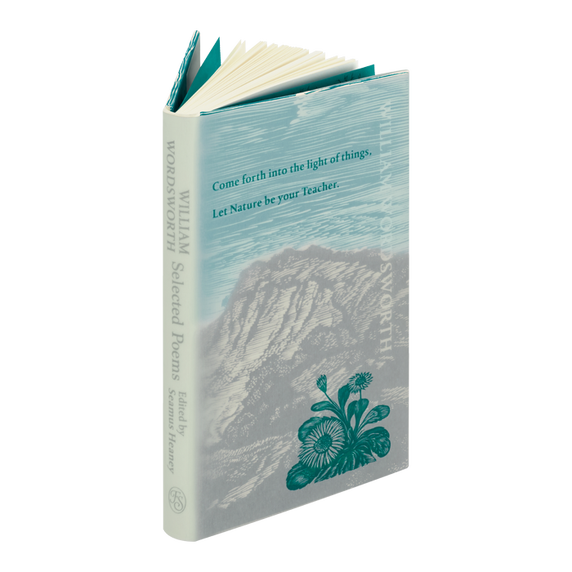
Published to mark the 250th anniversary of Wordsworth’s birth, Selected Poems is a celebration of the poet’s key shorter works selected and introduced by Seamus Heaney, with exquisite wood engravings by Peter Reddick.
Illustrated by Jane Lydbury
Introduced by Lavinia Greenlaw
A beautifully presented collection that celebrates the radical style of a visionary American poet. This edition follows the 1955 text prepared by Thomas H. Johnson, which presents the poems as Dickinson intended.
Throughout her life, and even more so since her death in 1886, Emily Dickinson was shrouded in paradox and mystery. From her late thirties onwards she rarely left her father’s home in Amherst, Massachusetts. This reclusion seems at odds with the expansive range of her poems and their passionate engagement with the agonies and joys of life. Though known to her fellow townsfolk as ‘the Myth’ and seldom seen by even some of her close relatives, Dickinson built strong friendships through the exchange of letters. More recent attempts to explain her solitude and understand her character, often guided by clues in her poems, have shifted our perception of her as a disappointed spinster towards that of a spirited and determined woman whose life turned upon the channelling of her extraordinary imagination.
‘Perhaps America’s greatest ever poet’
- Lavinia Greenlaw
Bound in printed cloth
Set in Bembo Book
160 pages
Frontispiece and 12 integrated black & white wood engravings
Printed endpapers
Printed translucent dust jacket
8¾˝ x 5½˝
Please note: this edition has a dust jacket in place of a slipcase
This Folio edition, introduced by the multi-award-winning poet Lavinia Greenlaw, features integrated wood engravings by Jane Lydbury. Like the binding design, they draw on Dickinson’s love of nature. The translucent dust jacket superimposes her figure on a wild, rural landscape, reflecting at once her removal from and deep connectedness to the world outside her home.
Dickinson wrote more than 1,800 poems, of which a mere handful were published in her lifetime. What’s more, her radical approach to rhyme, punctuation and capitalisation led her early editors to make substantial alterations to her verse, diluting her poems’ power in the process. This edition follows the 1955 text edited by Thomas H. Johnson, who restored the unique form of the originals. More than 170 poems are included here, among them ‘“Hope” is the thing with feathers—’, ‘Tell all the Truth but tell it slant—’ and ‘Because I could not stop for Death—’, as well as lesser-known works.
‘You speak kindly of seeing me; could it please your convenience to come so far as Amherst, I should be very glad, but I do not cross my father’s ground to any house or town’
- Letter from Emily Dickinson to the author Thomas Wentworth Higginson, as published in the Atlantic in 1891
Repelled by the flowery abstractions recited by the Church, Dickinson created a form all her own: audacious, oblique and arresting in its breathless transference of thoughts to the page. She embraces the largest of themes and penetrates their core in a few exacting lines, describing in ‘I heard a Fly buzz—’, for instance, not the apprehension of death but the moment of dying. She wittily expresses her scepticism towards ‘faith’ versus her regard for science, and makes clear her belief in the primacy of the self. Exploring the vagaries of the human mind, she delivers emotional insights with a precision and candour remarkable even by modern standards.
Dickinson took her work seriously, seeking mentors but rejecting fame: one poem wryly compares being ‘somebody’ to a frog croaking dumbly to ‘an admiring bog’. It was not until the 1950s that her verse, finding kinship with the transcendentalism of the Beat Generation, gained the widespread acclaim it deserved. An earlier transcendentalist did, however, admire her creations. It is easy to imagine that Ralph Waldo Emerson, who knew Dickinson’s brother, Austin, had her poems in mind when he declared: ‘For it is not metres, but a metre-making argument, that makes a poem, – a thought so passionate and alive, that, like the spirit of a plant or an animal, it has an architecture of its own, and adorns nature with a new thing.’
Emily Dickinson was born in Amherst, Massachusetts, in 1830. As a child she studied at Amherst Academy, and went on to attend the Mount Holyoke Female Seminary in South Hadley for one year, but the remainder of her life was spent in relative isolation in her family home. She seldom went out, or received visitors; she never married, and most of her friendships were dependent on correspondence. She wrote around eighteen hundred poems in her lifetime, but fewer than a dozen were published before her death in 1886, and those were significantly altered to fit poetic conventions of the time. Dickinson, now celebrated for her originality and distinct voice, is considered one of America’s greatest poets.
Jane Lydbury is a printmaker and illustrator. She studied Illustration at Camberwell College in the University of the Arts. Most of Lydbury’s illustration work has been in the form of printmaking, mainly wood-engravings with some linocuts. She exhibits regularly with the Society of Wood Engravers, and in 2011 was joint winner of the Rachel Reckitt prize.
Lavinia Greenlaw has published five collections of poems, most recently The Casual Perfect (2011) and A Double Sorrow: Troilus and Criseyde (2014). Her prose includes The Importance of Music to Girls (2007) and Questions of Travel: William Morris in Iceland (2011). Formerly Professor of Poetry at the University of East Anglia, she has held a number of posts, including British Council Fellow in Writing at Amherst College, Massachusetts. She also writes about music, art, landscape, vision and light, and has received many awards, including the Prix du Premier Roman Etranger for her novel Mary George of Allnorthover (2001) and the Ted Hughes Award for her sound work, ‘Audio Obscura’.
